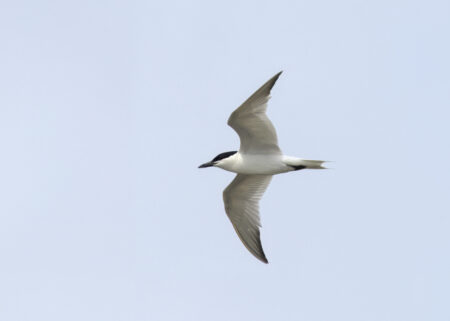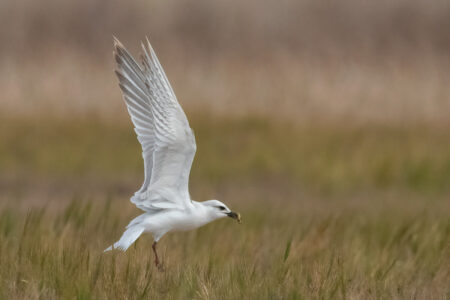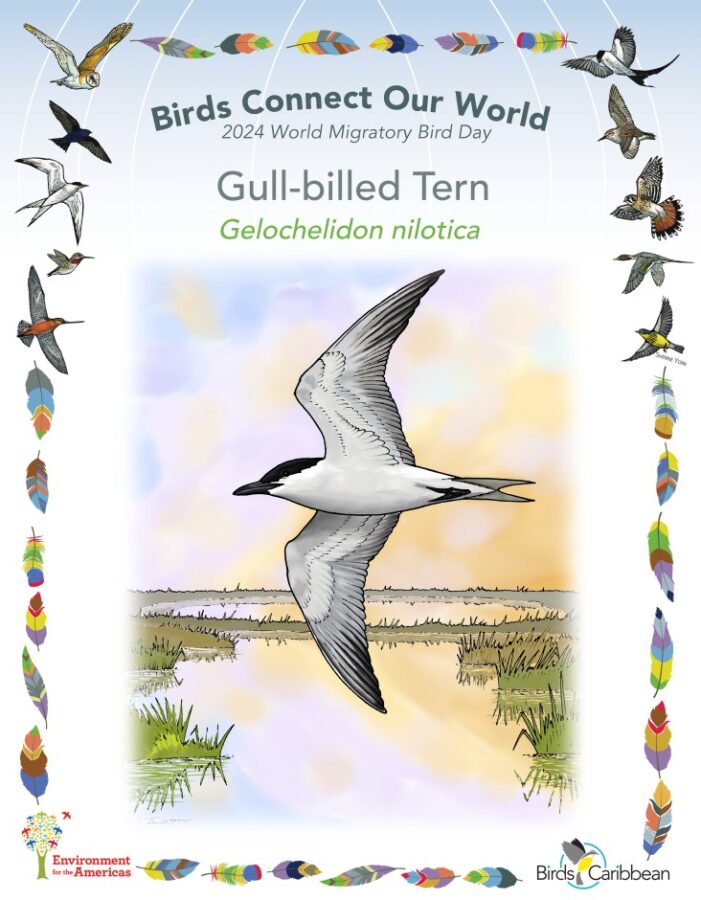Celebrate World Migratory Bird Day (WMBD) with us in 2024! This year’s theme is “Protect Insects, Protect Birds”. Have fun learning about a new migratory bird every day. We have coloring pages, interesting facts, activities, and more. Download for free and enjoy nature with your family at home.
Migratory Bird of the Day: Gull-billed Tern
Have you ever spotted a sleek, silver-gray and white tern with a thick black bill soaring gracefully above a saltmarsh, beach, or flooded field? You’ve likely encountered the Gull-billed Tern! This medium-sized bird can also be identified by its long black legs and slightly forked tail. During the breeding season, it sports a striking black cap, while in other months, its head has a more subtle black band stretching from the eyes to the back of the head. Juveniles, on the other hand, have fine dark speckles between the crown and back of the neck and warm brown mottling on the upper wings.
The Gull-billed Tern has an impressive range, with breeding populations scattered across the Americas (including the Caribbean), Europe, Africa, and Asia. Birds from North America and the Caribbean fly south to winter along the Gulf of Mexico and coasts of Central and South America, while some remain in the Caribbean. It breeds in select spots in The Bahamas, Cuba, Hispaniola, Puerto Rico, Virgin Islands, Cayman Islands, and Sombrero Island (Anguilla).
This adaptable bird thrives in various habitats. During the non-breeding season, it can be found foraging and resting in salt pans, coastal lagoons, marshes, and even plowed or flooded fields. Inland, it favors large rivers, lakes, rice paddies, sewage ponds, and irrigation canals.
When it’s time to nest, Gull-billed Terns prefer to nest in colonies on islands with sparse or no vegetation, or on sandbanks, dry mudflats, dunes, and even near wetlands like marshes and lagoons. It uses small stones and plant material to build nests and typically lays one to two eggs. This species appears less tolerant to human disturbance and is not as faithful to nesting sites as other gulls and terns.
Unlike many of its gull and tern relatives, Gull-billed Terns are not die-hard seafood lovers. They have a broad diet, and this where having a thick bill comes in handy. They hawk for insects in the air, pluck crabs, small reptiles and frogs from the ground, and snatch small fishes out of the water — without diving! They also boldly pilfer fish straight from the bills of other birds like the Common Tern. Occasionally, they’ll eat the chicks of other species, such as shorebirds and Least Tern!
What does this audacious tern sound like? Its call has been described as a slightly upslurred “kay-wek.” Its song is “raspy” and consists of 2-3 syllables.
Although their global population is stable, it’s crucial to share the shore with this and other waterbird species. Human disturbance can cause parents to abandon nests and chicks can die if driven away from the nest area too soon. So when you’re near their habitat, remember to give these birds space, keep dogs leashed, and clean up after yourself. You can find more tips on sharing the shore and a free downloadable infographic here.
Keep your eyes to the skies and your senses sharp — spotting this charismatic seabird is always a thrill! Whether it’s soaring gracefully or acrobatically hunting its insect prey, the Gull-billed Tern never disappoints. Happy birding! Learn more about this species, including its range, photos, and calls here. Great news! If you’re in the Caribbean, thanks to BirdsCaribbean, you have free access to Birds of the World and you can find out even more in the full species account of this bird!
Thanks to Antonio Garcia Quintas for the text and Arnaldo Toledo for the lovely illustration!
Color in the Gull-billed Tern
Download the Migratory Birds of the Day Coloring Page! Use the picture above and the photos on this page as your guide, or look up pictures of the bird online or in a bird field guide if you have one. Share your colored-in page with us by posting it online and tagging us @BirdsCaribbean #WMBD2024Carib
Listen to the calls of the Gull-billed Tern
The call of the Gull-billed Tern is a lightly upslurred “kay-wek”
Enjoy these photos of Gull-billed Tern


Activity of the Day
 FOR KIDS: Four our activity today why not imagine that you are a Gull-billed Tern and complete the My Migration Adventure creative writing activity!
FOR KIDS: Four our activity today why not imagine that you are a Gull-billed Tern and complete the My Migration Adventure creative writing activity!
We have provided a template for you to write a short story about a migration journey. Pretend that you are a migrating Gull-billed Tern flying from the US to the warm and sunny Caribbean. Imagine getting ready to make this epic journey: how would you be feeling having to fly so far? Think about the places you will see along the way and perhaps about other migratory birds you could ‘meet’ on the way.
This is a long journey so you should also think about challenges you, as a Gull-billed Tern, might face!
As well as writing about the journey you might also want to add some pictures to your story. Perhaps you could add a map of where you would be traveling or you could add some pictures of the other migratory birds on the route, of a particular challenge you might face or of a ‘rest stop’.
FOR KIDS AND ADULTS: Enjoy this video of a Gull-billed Tern in the wild! First in breeding plumage and then, in winter plumage without its black cap.


